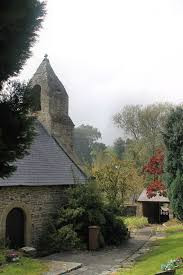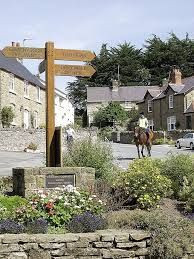Best Kept Community Village 2019
Llanasa
Llanasa [find me]
Introduction
Llanasa shelters in the bottom of a narrow U-shaped valley that runs eastwards to the Dee estuary coastline about 3km away, with higher ground to the north and south. The settlement has grown up near the head of a stream known as Afon y Garth, with some houses on the valley floor, others together with the church on the lower northern slope above the stream. It is served only by minor roads. Prestatyn is 5km to the north-east, Holwyell 10km to the south-east.
The Norwich Taxation of 1254 discloses the first occasion when Llanasa appeared in print, as 'Llanassa'. Subsequently 'Lanasaph’ appeared in 1291 in the second of the great taxation records of the 13th century, and in about 1700 the variations were summed in the reference to "Llanassa alii Lhan Asaph et Hassa".
Some medieval nucleation might be anticipated but there is nothing to corroborate what is no more than speculation. Edward Lhuyd at the end of the 17th century revealed that there were six houses close to the church.
Village heritage to 1750
Named after Saint Asaph the village is known to have existed since at least c.600 AD and was originally called Llanasaph meaning the Church of Saint Asaph. It was where the tomb and relics of Saint Asaph were enshrined before they were moved to the larger St Asaph Cathedral sometime before 1281
The oldest recorded vernacular building in the village is Henblas, a Grade 1 Early Renaissance example from 1645. A three-storied stone building with mullioned windows. Groes Cottages to the north-east of the village, dated 1674. The Old Gyrn Arms at the bottom of Axton hill, dated 1675, while Henblas Lodge and the Old Post Office are accredited with 17th century origins. The parkland associated with Gyrn Castle (a Grade II listed building circa 1817), 300m to the east, stretches as far as the village edge. Within this parkland and close to the built up area is a large terraced platform, clearly artificial, its purpose is unknown. It is adjacent to the track that now leads to the castle, though originally this was probably the main route down the valley.
To the west of the village by approximately 1500 metres lies Golden Grove, a Grade I listed Elizabethan manor house built in 1578 in 1,000 acres . It was built by Sir Edward Morgan and renovated during the reign of Queen Anne. It was passed down through the Morgan family, several of whom were Sheriffs of Flintshire, until 1877.
Llanasa parish church
The church is double-naved and in the Perpendicular style. The churchyard has a quadrilateral shape, and there is no trace of an earlier curvilinear enclosure. It is set on a slope and because of this the church itself has been terraced into the hillside. The current church was built in the 15th century, although various alterations were made in subsequent centuries. It replaced an earlier church, dedicated to saints Asaph and Kentigern, which is mentioned in the Domesday Book of 1087. Llanasa is a shortened form of Llanasaph (denoting an enclosure dedicated to St Asaph). By 1281, St Asaph’s relics had been moved from the church to the recently built St Asaph Cathedral.
The current church incorporates some stonework from the earlier church. It features a double nave, tomb slabs from the 14th century and a pulpit from the 17th century. The sepulchral stone bearing the coat of arms of Gruffydd Fychan, the father of the Welsh freedom fighter, Owain Glyndwr, lies within the church vestry. It bears the lion rampant with a sword underlying the shield.
It is inscribed around the edges and is typical of a 14th century masons' decorative work.
Stained glass at the eastern end is thought to have been moved here from Basingwerk Abbey, near Holywell, when it was dissolved under Henry VIII in 1536. A model of the abbey made by the architect Geraint Roberts (who grew up in Llanasa) is displayed inside the church.
In 2010 stained glass windows to the west, were bequeathed by Edward Howatson (who lived at Plas yn Llan farm). He was a passionate conservationist, and the windows reflect his love of nature as well as his Christian preferences.
The church contains a memorial to the 13 crew members of the Point of Ayr lifeboat who drowned on a stormy night in January 1857 as they tried to rescue sailors from the Belfast schooner Temperance. 7 of them are buried in the village cemetery.
There is a memorial inside the church commemorating those who died in WW1. The Memorial Garden next to the lychgate also commemorates those from the parish, who died in The Great War. The neighbouring village of Picton also commemorates those who never returned from WW1.
In the churchyard close to the main entrance, is the grave of the Unknown Serviceman, representing the 70 who perished on the SS Apapa after a torpoedo attack off the coast of Anglesey, in 1917.
Sir Piers Mostyn rests here. He died in 1605, although the slab on top is from a later period. He was a member of the dominant local landowning family. Sir William of Gwespyr, Thomas ap Hugh, Lord and Lady Bates (Gyrn Castle) rest here too.
There is a sundial dating from 1762. The lychgate was built in 1725.
1971
2019




